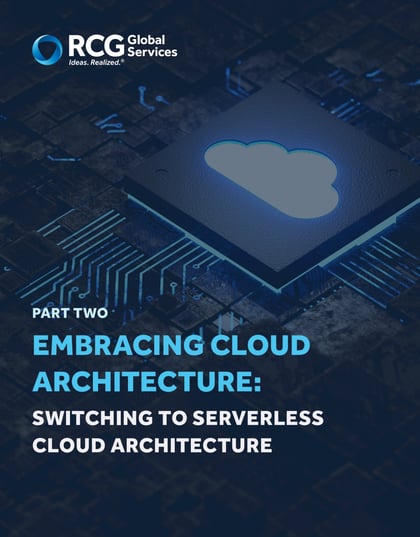Embracing Cloud Architecture: Switching to Serverless Cloud Architecture
Part 2
Modern Cloud Architecture Series

- MACH Enterprise Architecture
- Serverless Cloud Architecture
- Modern Cloud Data Platform Architecture (Coming Soon)
- MLOPs Cloud Architecture (Coming Soon)
What is Serverless Architecture?
Serverless computing is an evolution of cloud computing that removes the user’s job of installing, provisioning, maintaining, scaling up/down, and upgrading servers. It enables a simpler, more cost-effective way to build and operate cloud-native applications, in which the cloud provider allocates machine resources on-demand, taking care of the servers on behalf of their customers. For businesses, this means manual infrastructure management tasks are eliminated, so teams can focus on writing code that serves their customer’s ongoing needs.
A serverless system automatically:
- provisions the computing resources required to run application code, manage
data, and integrate applications all without managing servers on-demand, or in response to a specific event - scales those resources up or down in response to increased or decreased demand
- scales resources to zero when the application stops running, the database stops being queried or they become idle
- Using serverless cloud-native product offerings, users are able to write and deploy code and manage datastore and application integrations while the cloud provider dynamically manages the allocation and provisioning of servers
Payments & Management Structures
A significant difference between on-premise and cloud computing is the payment structure and management of resources. Different models involve varying levels of management by cloud providers, with serverless offering full management.
On-Premise – In an on-premise legacy structure, you manage and pay for all resources.
IaaS & Paas Models – In infrastructure-as-a-service (IaaS) and platform-as-a-service (PaaS) models, only some resources are managed by your vendor. Other resources must be paid for from the time you provision them until the time you explicitly decommission them.
Serverless Model – In a serverless model, all resources are managed by your vendor, meaning you only have to pay for resources when they are being used. Payment starts when a request is made and ends when execution finishes. Customers never pay for idle capacity.
Why Serverless?

For developers, built-in service integrations and high availability, and the third-party management of infrastructure tasks all free up
time to focus on customer needs. For business leaders, lower costs and improved scalability mean faster implementation of strategic business improvements. Some of the major benefits of serverless architecture for business owners include:
Lower costs
Serverless computing is generally very cost-effective, as traditional cloud providers of backend services (server allocation) often require the user to pay for unused space or idle CPU time.
Simpler pricing model
A serverless cost model is pay-per-execution, which offers a great deal of simplicity on highly unpredictable production and test workloads.
Global auto scalability
Developers using serverless architecture don’t have to worry about policies to scale up their code. The serverless model handles all scaling on demand.
Focus on the business
Serverless cloud computing allows the project team to focus on what really matters for the business, that is, the development of the app itself, thus achieving results with less team members.
Improved latency
With serverless computing, providers have points of presence near every user, and apps perform equally well for everyone.
Simplified backend code
With function-as-a-service (FaaS), developers can create simple functions that independently perform a single purpose, like making an API call.
Stability
Developers no longer have to worry about facilitating infrastructure, orchestrating and allocating code data, handling downtime, network and performance issues, and managing failures as they used to do on legacy on-premise software platforms.
Improved DevOps
Serverless architecture simplifies deployment and, in a larger sense, simplifies DevOps cycles and operations because developers don’t have to describe the infrastructure needed to integrate, test, deliver and deploy code builds into production.
Eliminate DBA Tasks
A serverless database model is built on the separation of storage and compute which scales independently, automatically starts up, shuts down, and scales capacity up or down based on the workload. It enables you to run your database in the cloud without managing any database capacity, instance, cluster, or node configurations.
Agility
Serverless architecture can significantly cut time to market. Instead of needing a complicated deployment process to roll out bug fixes and new features, developers can add and modify code on a piecemeal basis.
How can Serverless Architecture Benefit your Industry?

RCG’s cloud engineering team is very proud of our capabilities to build customized and innovative end-to-end serverless cloud solutions for our customers. At RCG, we are currently executing and have delivered many cloud projects for clients across various industry verticals using modern Serverless cloud architecture on AWS, Azure and GCP and helping customers to:
- achieve operational and management efficiency
- enhance customer satisfaction and get simplified operations
- make business more inclusive, globally scalable, and profitable
- get secure operations without worrying about data storage regulations
- cut down on expenses and create products at cheaper costs
- gain maximum business value and increase your profits
- Every industry can benefit from enabling serverless architecture.
Consumer
Serverless computing outsources the management of tasks associated with programming, freeing retailers from the responsibility of standard issues like scalability and security. This allows them to focus on projects that enhance brand
experience and improve time to market.
In Figure 3, the architecture shows how to set up a real-time messaging service to share the live location of the delivery service on Azure. This scenario describes how to architect a serverless solution that processes changes to underlying data within a web view without the need for a page refresh using real-time services. This example can also be useful for users trying to build a real-time location-sharing, asset-tracking, and price-update platforms for their web or mobile applications.
RCG has broad experience serving consumer needs. Uniquely positioned in IT consulting, we’re equipped to assist clients across the retail, travel, and hospitality industries.
Banking & Finance
The cost-effective and event-driven nature of serverless computing makes it a beneficial structure for the banking and finance industry. Since serverless applications maximize on-demand-only costs, when services are not required, the chargeback is zero. Financial services’ highly variable workloads (for example, recurring yet temporary risk and repricing calculations) can benefit from serverless.
A smart analytics design pattern enables you to build a scalable real-time fraud detection solution using GCP serverless, no-ops products on Google Cloud. In addition to setting up fraud notifications, you can build dashboards to monitor the performance of the fraud detection pipeline. Because the Google Cloud products used in this solution are serverless and fully managed, you won’t need to spend time setting up and maintaining infrastructure, enabling you to focus on getting the solution up and running in only a few hours.
Banking and finance can be a complicated industry to navigate due to strict regulatory compliance standards, as well as high performance, security, availability and reliability requirements. RCG has more than four decades of success serving major banking & financial clients using modern architecture and latest cloud technologies.
Insurance
Serverless architecture offers engineering experience, a customer-centric approach, and a strong focus on security—a top priority in the highly regulated insurance industry.
By using serverless architecture, the insurance provider can become more agile, releasing higher-quality solutions for customers on a faster timeline while reducing costs and removing the responsibility of infrastructure maintenance from staff.
Despite existing property and casualty insurance companies’ best efforts, the process of buying home, auto, or specialty insurance, let alone bundling them together, is rarely easy or clear. Rates change, coverage is confusing and understanding why is anything but intuitive.
Serverless computing enables engineers at insurance companies to build event-driven systems faster because it speeds up the feedback cycle so that the systems iterate more efficiently, reminding the engineers and architects that they shouldn’t be writing code when they don’t need to be writing. The engineering team can shift their focus from the nuts and bolts of building to using the building blocks of serverless architecture to quickly add business value.
As shown in Figure 5 of AWS Reference Architecture, by using AWS serverless technologies as building blocks, an insurance business can rapidly and interactively build data lakes/warehouse and data processing pipelines to ingest, store, transform and analyze petabytes of structured and unstructured data from batch and streaming sources—all without needing to manage any storage or compute infrastructure.
These advanced analytics capabilities can help the insurance industry:
- mitigate risks
- detect insurance frauds
- make predictive machine learning models for underwriters & agents
- offer better rates to low-risk profiles
- perform quotes
- claim analytics
- simplify and speed up the policy renewal process
- enable agents and marketing teams to cross-sell & up-sell
- target specific groups of people in communities to grow the business
For the insurance industry, understanding customer context and relationships is key. At RCG, we have a rich history helping Insurers and InsurTech organizations in the global 1000 marketplace to achieve a competitive digital transformation.
Ready for Serverless?

By removing the user’s job of manually managing infrastructure tasks, serverless enables a simpler, more cost-effective way to build and operate cloud-native applications. With features such as improved DevOps, simplified backend code, and global auto scalability, developers are able to respond to changing customer needs quickly and efficiently. For organizations across every industry, serverless architectures create the time and budget needed to focus on business outcomes.
RCG Cloud Engineering
At RCG, we use a business outcome focus to help customers determine their best approach to working on the cloud. From there, we assist with:
Leveraging our proprietary tools, technology partners, and breadth of expertise and experience, we help customers reach their goals quickly, helping them to realize the future of the cloud today.
Learn more about our cloud engineering services.
Up Next

Modern Cloud Data Platform Architecture
In part three of our cloud architecture series, we’ll discuss cloud-native, purpose-built data platforms on three major cloud providers. These platforms provide scalable platforms that provide methods to enrich data for self-service and enable a trusted data platform to drive self-service reporting and automated analytic services. The modern cloud data platforms allow customers to build data-driven, highly scalable, distributed applications.
RCG has experience building a trusted data foundation across all 3 CSP’s providing best practices on data ingestion, cataloging of data assets, data quality driven approach (Delta Lake), curated data assets (Lakehouse), data marketplace to drive self-service reporting and analytics, and end-to-end automation of analytic models. We might also discuss end to end automation of analytic models. Architecture, users will be able to pick the best solution to solve a specific problem and break away from restrictive commercial databases to focus on building applications to
meet the needs of their organization.
Download a PDF version of this guide by filling out this form


